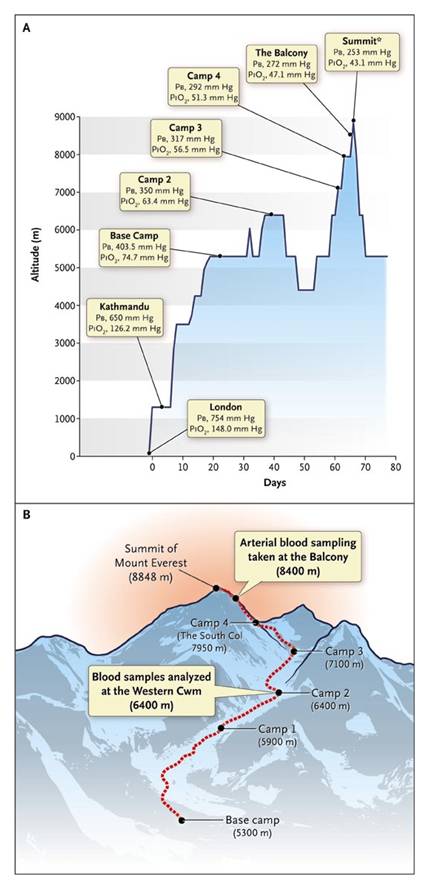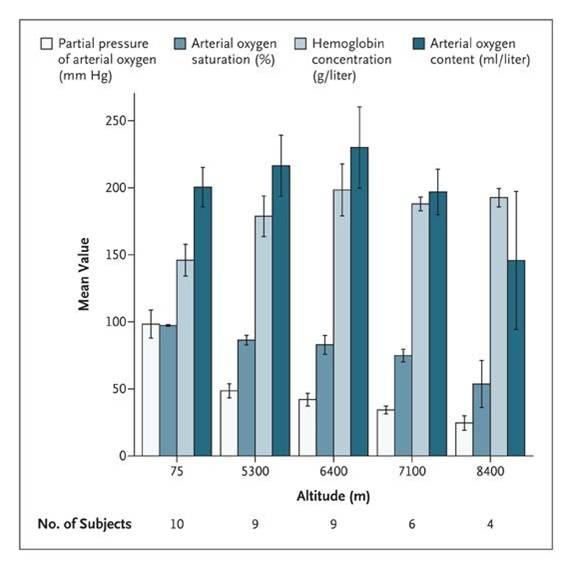* Values in mm Hg (BP = barometric pressure). Click on location for discussion of blood gas values.
| Location |
Altitude (m/ft) |
BP* |
PIO2* |
pH |
PaCO2* |
PaO2* |
SaO2 |
| Summit |
8848 / 29,029 |
253 |
43 |
@7.7 |
7.5 |
28 |
@70% |
| Balcony |
8400 / 27,559 |
272 |
47.1 |
7.53 |
13.3 |
24.6 |
54% |
| Camp 4 |
7950 / 26,083 |
292 |
51.3 |
- - |
- - |
- - |
- - |
| Camp 3 |
7100 / 23,294 |
317 |
56.5 |
7.53 |
16.7 |
35 |
-- |
| Camp 2 |
6400 / 20,997 |
350 |
63.4 |
7.51 |
18.2 |
40 |
- - |
| Camp 1 |
5900 / 19,358 |
- - |
- - |
- - |
- - |
- - |
- - |
| Base Camp |
5300 / 17,388 |
403.5 |
74.7 |
7.46 |
20.4 |
47 |
- - |
| Sea level |
0 / 0 |
760 |
140 |
7.40 |
40 |
>80 |
98% |


Mt. Everest was first summited by Sherpa Tenzing Norgay and New Zealander Edmond Hillary
with a British expedition on May 29, 1953; they took the South Col route shown. They used
supplemental oxygen, as did all subsequent climbers for the next 25 years.
On May 8, 1978, Reinhold Messner from Italy, and Peter Habeler from Austria,
made the first ascent without supplemental oxygen. Messner summited without
supplemental O2 a second time, from a different route, on August 20, 1980.
It is now estimated that less than 4% of current climbers go without
supplmental oxygen (quoted in
NEJM 2009). For detailed geography, climbing routes and history of ascents, see
Wikipedia article on Mt. Everest. For
first person accounts of climbing Mt. Everest, including the notorious 1996 expedition ("Into
Thin Air"), see list of Amazon-linked books at bottom of web page. (See
Climbing Mt. Everest for more information on unique feats associated with climbing
the mountain.)
(Note: The summit altitude is variously given as either 29,029 feet (8848 M)
or 29.035 feet (8850 M), an inconsequential difference.)
There are two simulation studies (ABGs drawn on subjects
in a hypobaric chamber to simulate the summit
altitude) and one study whereby pH, PaO2 and SaO2 were inferred from exhaled
gases obtained in a single climber at the summit
(West, et al). In both the simulated studies and the actual
climber, survival was possible because the subjects had been able to acclimatize
to the low pressure environment for many days. Values for PaCO2, PaO2 and SaO2 in
the hypobaric studies are mean of the number of subjects studied.
The pH and SaO2 values in the West study are considerbly higher than the
chamber values, because the PaCO2 (assumed equal to the climber's exhaled PCO2) was
considerably lower. All authors acknowledge that no chamber can simulate the
actual extreme conditions on the summit, which could affect the climber's
ventilatory status.
For further discussion of PaO2 and the alveolar gas equation at this
altitude, please see the section Sea level.
Sea level
Below are the standard values at sea level, compared with those at the summit
of Mt. Everest. ("Summit" includes data from both the single climber and the
chamber studies; see Summit section.)
| Location |
Altitude (meters / ft) |
BP |
PIO2 |
pH |
PaCO2 |
PaO2 |
SaO2 |
Summit |
8848 / 29,029 |
253 |
43 |
7.56 - @7.7 |
7.5 - 11.9 |
28-30.6 |
58% - @70% |
| Sea level |
0 / 0 |
760 |
140 |
7.40 |
40 |
>80 |
98% |
Note that with altitude the barometric pressure (BP) falls, but the FIO2 stays constant
at 21% of the atmosphere. The drop in BP reduces the inspired partial pressure of
oxygen (PIO2), which in turn reduces the alveolar partial pressure of oxygen (PAO2).
In the
2009 NEJM study PAO2 was calculated using the long form of the
alveolar gas equation:
1-FIO2
PAO2 = PIO2 - PACO2 [ FIO2 + -----------------]
R
Where:
PIO2 = FIO2 (BP - 47 mm Hg)
(47 mm Hg is the water vapor pressure in the upper airway,
a constant at all altitudes)
PACO2 = Alveolar PCO2, which is assumed to = arterial PCO2 (PaCO2). It
is the value for PaCO2 that is used in the alveolar gas equation.
FIO2 = Fraction of inspired oxygen, which is 21% at all altitudes when
breathing ambient air.
R = respiratory quotient, which is ratio of ml CO2 produced/ml O2 taken up by
the lungs, normally about 0.80 at rest.
In this study respiratory quotient (R) was measured in 3 of the climbers the day before
summiting, at an altitude of 7950 meters. The 3 values were 0.81, 0.72 and 0.70.
When using the alveolar gas equation for clinical purposes,
R is assumed to be 0.80 and PaCO2 is assumed = to PACO2. These assumptions
give the familiar 'abbreviated alveolar gas equation':
PAO2 = PIO2 - 1.2(PaCO2)
At the summit:
PIO2 = .21(253-47) = .21(206) = 43.26 mm Hg
If the climber's PaCO2 stayed anywhere near 40 mm Hg
this would not be a survivable situation, as shown by a simple calculation:
PAO2 = PIO2 - 1.2(PaCO2)
PAO2 = 43 mm Hg - (1.2)40 mm Hg = 43 - 48 = -5 mm Hg!!
A negative alveolar PO2 would mean, of course, that oxygen would go
the other way - leave the blood and enter the atmosphere
Without supplemental oxygen, survival is possible at these altitudes because
of prolonged acclimatization, which allows for chronic, sustainable hyperventilation.
Thus, using the PCO2 values for the summit
(West's value of 7.5 mm Hg and mean of the two hypobaric study
PaCO2s = 11.6 mm Hg) and the balcony mean PaCO2 of 13.3 mm Hg:
|
Summit (29,029 ft.): PAO2 = 43 - 7.5(1.2) = 43 - 9 = 34 mm Hg
Summit (29,029 ft.): PAO2 = 43 - 11.6(1.2) = 43 - 14 = 29 mm Hg
Balcony (27.559 ft): PAO2 = 47 - 13.3(1.2) = 47 - 16 = 31 mm Hg
|
Note that these values -- 34, 29 and 31 mm Hg -- are for ALVEOLAR PO2.
Assuming an alveoar-arterial PO2 difference of @5 mm Hg, we see that
the PaO2 breathing ambient air, at either location,
is in the mid to high 20s -- surely near the limit of survivability.
As noted above, the vast majority of current climbers use
supplementary O2 when attempting the summit of Mt. Everest. An interesting journal
letter noted the following data for
Everest and K2 summiters between 1978 and 1999. shown in the two tables below.
(Supplemental
oxygen and mountaineer death rates on Everest and K2.
JAMA 284:2000;181)
| Mt. Everest |
# ascents |
# deaths |
% deaths |
| Using supplementary O2 |
1077 |
32 |
3 |
| No supplementary O2 |
96 |
8 |
8.3 |
The differences were even more striking for K2, the planet's 2nd highest mountain.
| K2 |
# ascents |
# deaths |
% deaths |
| Using supplementary O2 |
47 |
0 |
0 |
| No supplementary O2 |
117 |
22 |
18.9 |
One can see why the altitude one must reach to summit these
mountains is sometimes called the
"death zone".
Books on climbing Mt. Everest and K2, with links to Amazon.com
Into Thin Air, by Jon Krakauer
The Climb, by Anatoli Boukreev
Left For Dead, by Beck Weathers
High Exposure: An Enduring Passion for Everest
and Unforgiving Places, by David Brashears
No Shortcuts To The Top, by Ed Viesturs
Himalayan Quest, by Ed Viesturs
Everest: Mountain Without Mercy, by Broughton Coburn
K2, The Savage Mountain, by Charles S. Houston



